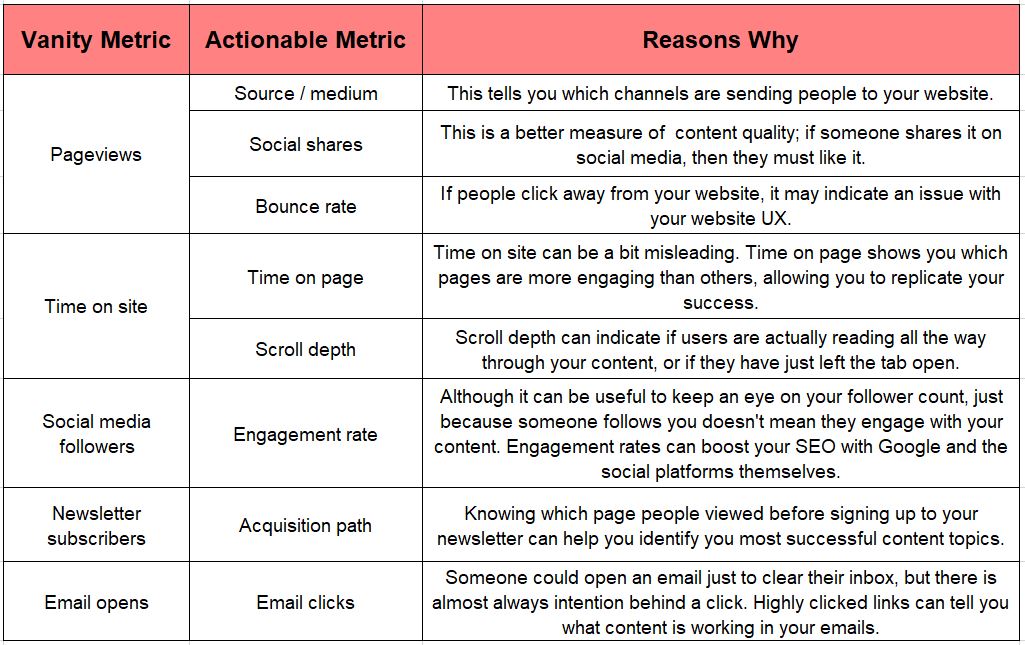media update’s Aisling McCarthy reveals the three steps to identifying the metrics that really matter.
In the digital era, metrics are ubiquitous. And measuring all of them often leaves you with masses of data and no idea how to interpret it.
Being able to differentiate between vanity and actionable metrics can ensure that you only spend time gathering and analysing the stats that are actually important.
So, how do you identify actionable metrics?
Step 1: Know your marketing goals
The first step to ensuring that you measure the
right metrics is to define what your marketing goals are. Once you’ve done that, you’ll be able to link your business objectives to specific metrics.
For example, if your goal is to improve your social media visibility, then social media engagement would be an actionable metric to track. Post reach is purely a vanity metric in this case as it only shows you how many people may have seen your content. Although your reach will be higher than your engagement on a particular post, when people have engaged, you know that they looked at your content.
Wondering which metrics match other marketing goals?
- Improving brand awareness → Increased new site visitors
- Improving content quality → Increased scroll depth
- Improving SEO → Increased ranking for a specific keyword
Step 2: Audit your current metrics
Chances are, you are already have some kind of analytics reporting in place — no matter how basic. However, many of those metrics are likely to be vanity metrics that make you feel good about your efforts, but don’t really help you measure your goals.
In order to weed out the vanity metrics from the actionable ones, ask yourself:
- What am I measuring with this metric and why?
- What does this metric tell me about my marketing efforts?
- How does this metric relate to my marketing goals?
- What changes should I make based on this metric?
If you find that the metrics you are analysing are vanity metrics, then consider which other metrics may better help you measure your performance.
As an example, let’s consider that you run a small marketing agency and your main goal is to increase brand awareness. To do this, you’re focussed on measuring website pageviews.
Let’s take this metric through the vanity filter questions listed above:
- What are we trying to measure with the pageviews metric? We’re trying to measure how many people view the website because that is an indicator of increased visibility.
- What do pageviews tell us about our marketing efforts? The metric tells us if our holistic marketing efforts are successfully driving more people to the website.
- How do pageviews relate to my marketing goals? Since we’re focussed on brand awareness, the number of people who view the website is directly linked to the amount of people who are aware of our brand.
- What changes should we make based on pageviews? If pageviews are low, we may need to look at optimising for SEO or making changes to the content. If pageviews are high, we can analyse the top pages, see what qualities they possess and try to recreate them on other pages.
Step 3: Turn vanity metrics into actionable metrics
If, in step two, you’ve discovered that you are actually measuring vanity metrics and you’re unsure of how to convert them into actionable ones, read on!
The table below shows some of the most commonly measured vanity metrics and the actionable metrics that are related.

Measuring actionable metrics gives you richer insights into your marketing efforts than measuring vanity metrics. The biggest tell-tale sign that a metric is actionable is the insight it gives you.
If you can make adjustments or improvements to your strategy based on metrics, then you’re measuring the right ones! If not, then you may be dealing with vanity metrics. Typically, metrics like reach, followers and views are vanity metrics, but they
may be classed as actionable — depending on what your marketing goals are.
What other steps can you take to ensure you are measuring actionable metrics? Share your thoughts with us in the comments section below.
That was exciting, wasn’t it? To get more insightful stories delivered straight to your inbox, sign up to our newsletter.
Now that you’ve got your social and website metrics under control, how do you measure your content? Check out our infographic for the Five content marketing metrics you need to measure.
*Image courtesy of Vecteezy